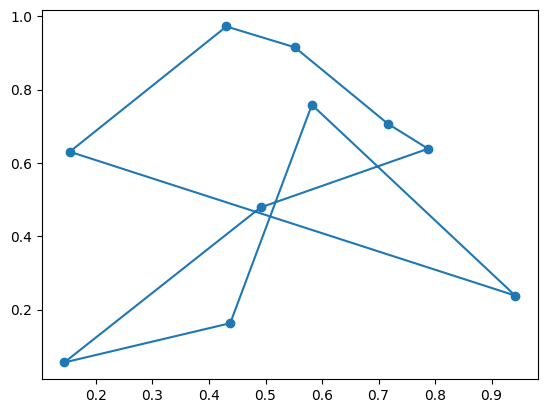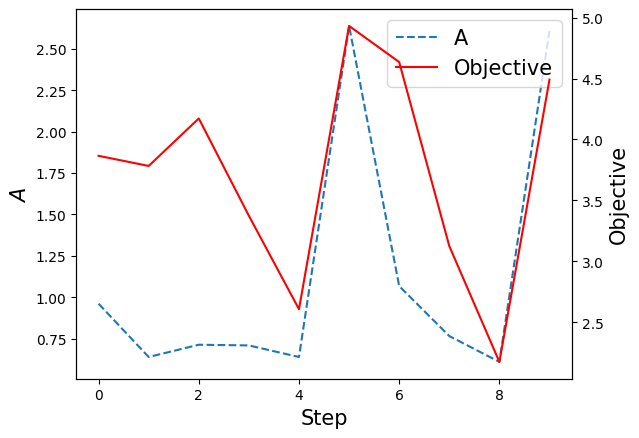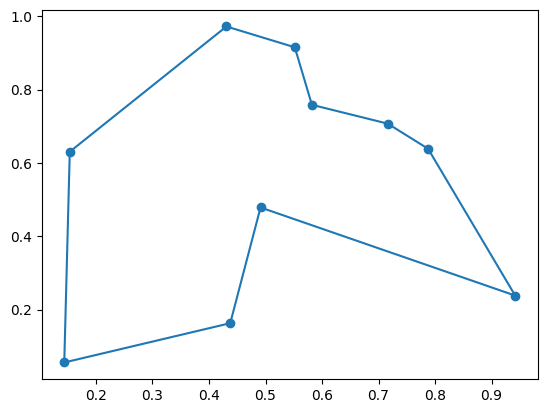Transpiler Tutorial for TSP with QUBO solver
# install jijmodeling-transpiler
!pip install jijmodeling-transpiler
!pip install openjij
import jijmodeling as jm
import openjij as oj
import jijmodeling_transpiler as jmt
import numpy as np
import matplotlib.pyplot as plt
d = jm.Placeholder("d", ndim=2)
n = d.len_at(0, latex="n")
i, j, t = jm.Element("i", n), jm.Element("j", n), jm.Element("t", n)
x = jm.BinaryVar("x", shape=(n, n))
problem = jm.Problem("TSP")
# Objective function
problem += jm.sum([i, j], d[i, j]*jm.sum(t, x[i, t]*x[j, (t+1) % n]))
# Constraints
jmC = jm.Constraint
problem += jmC("one-time", x[i, :].sum() == 1, forall=i)
problem += jmC("one-city", x[:, t].sum() == 1, forall=t)
problem
Transpile to QUBO
# Prepare data to create instance
def random_2d_tsp(n: int):
x = np.random.uniform(0, 1, n)
y = np.random.uniform(0, 1, n)
XX, YY = np.meshgrid(x, y)
distance = np.sqrt((XX - XX.T)**2 + (YY - YY.T)**2)
return distance, (x, y)
num_city = 10
distance, (pos_x, pos_y) = random_2d_tsp(n=num_city)
plt.scatter(pos_x, pos_y)
plt.xlim(0, 1)
plt.ylim(0, 1)
plt.show()
# Substitute data to the mathematical model
compiled_instnace = jmt.core.compile_model(problem, {"d": distance})
# Transpile to QUBO
qubo_builder = jmt.core.pubo.transpile_to_pubo(compiled_instnace)
Why PUBO?
The transpile_to_pubo function is designed to transform a given mathematical model into a Polynomial Unconstrained Binary Optimization (PUBO) formulation. The term "PUBO" stands for Polynomial Unconstrained Binary Optimization, a more generalized form of Quadratic Unconstrained Binary Optimization (QUBO).
multipliers = {"one-time": 1.0, "one-city": 1.0}
qubo, offset = qubo_builder.get_qubo_dict(multipliers=multipliers)
Optimize by QUBO SA Sampler
sampler = oj.SASampler()
response = sampler.sample_qubo(qubo)
Decode the response from openjij
decoded = jmt.core.pubo.decode_from_openjij(response, qubo_builder, compiled_instnace)
feasibles = decoded.feasible()
objectives = np.array(feasibles.evaluation.objective)
lowest_index = np.argmin(objectives)
print(f"Lowest solution index: {lowest_index}, Lowest objective value: {objectives[lowest_index]}")
Lowest solution index: 0, Lowest objective value: 4.261925958221673
# check solution
nonzero_indices, nonzero_values, shape = feasibles.record.solution["x"][lowest_index]
print("indices: ", nonzero_indices)
print("values: ", nonzero_values)
indices: ([0, 1, 2, 3, 4, 5, 6, 7, 8, 9], [4, 0, 1, 7, 5, 3, 6, 2, 8, 9])
values: [1.0, 1.0, 1.0, 1.0, 1.0, 1.0, 1.0, 1.0, 1.0, 1.0]
Draw tour
def convert_to_tour(nonzero_indices, num_city):
tour = np.zeros(num_city, dtype=int)
i_value, t_value = nonzero_indices
tour[t_value] = i_value
tour = np.append(tour, [tour[0]])
return tour
tour = convert_to_tour(nonzero_indices, num_city)
tour
array([1, 2, 7, 5, 0, 4, 6, 3, 8, 9, 1])
plt.scatter(pos_x, pos_y)
plt.plot(pos_x[tour], pos_y[tour], "-")
plt.show()

Optimize the weights of penalties.
num_iter = 10
num_reads = 1
alpha = 1.2
results = []
A = np.max(distance)
Ahistory = [A]
best_tour = None
best_objective = np.inf
for i in range(num_iter):
# re-put the parameters of TSP and make QUBO
qubo, _ = qubo_builder.get_qubo_dict(multipliers={"one-city": A, "one-time": A})
response = sampler.sample_qubo(qubo, num_reads=num_reads)
decoded = jmt.core.pubo.decode_from_openjij(response, qubo_builder, compiled_instnace)
feasibles = decoded.feasible()
if len(feasibles.evaluation.objective) == 0:
# If no feasible solution is obtained, increase the penalty parameter and try again.
one_time_violaiton = np.mean(decoded.evaluation.constraint_violations["one-time"])
one_city_violaiton = np.mean(decoded.evaluation.constraint_violations["one-city"])
A += one_city_violaiton + one_time_violaiton
else:
argmin_e = np.argmin(feasibles.evaluation.objective)
nonzero_indices, _, _ = feasibles.record.solution["x"][argmin_e]
tour = convert_to_tour(nonzero_indices, num_city)
if feasibles.evaluation.objective[argmin_e] < best_objective:
best_objective = feasibles.evaluation.objective[argmin_e]
best_tour = tour
dij_dik = []
for t, _i in enumerate(tour):
_j = tour[(t-1)%num_city]
_dij = distance[_i, _j]
_k = tour[(t+1)%num_city]
_dik = distance[_i, _k]
dij_dik.append(_dij + _dik)
# Update rule using the structure of TSP
A = alpha * np.max(dij_dik)/2
Ahistory.append(A)
results.append(decoded)
objective = [np.mean(r.evaluation.objective) for r in results]
fig = plt.figure()
ax1 = fig.add_subplot(111)
ln1 = ax1.plot(Ahistory[:-1], "--", label="A")
ax2 = ax1.twinx()
ln2 = ax2.plot(objective, c="r", label="Objective")
h1, l1 = ax1.get_legend_handles_labels()
h2, l2 = ax2.get_legend_handles_labels()
ax1.legend(h1+h2, l1+l2, loc='upper right', fontsize=15)
ax1.set_xlabel('Step', fontsize=15)
ax1.set_ylabel(r'$A$', fontsize=15)
ax2.set_ylabel('Objective', fontsize=15)
Text(0, 0.5, 'Objective')

# plot the best solution
plt.scatter(pos_x, pos_y)
plt.plot(pos_x[best_tour], pos_y[best_tour], "-")
plt.show()
